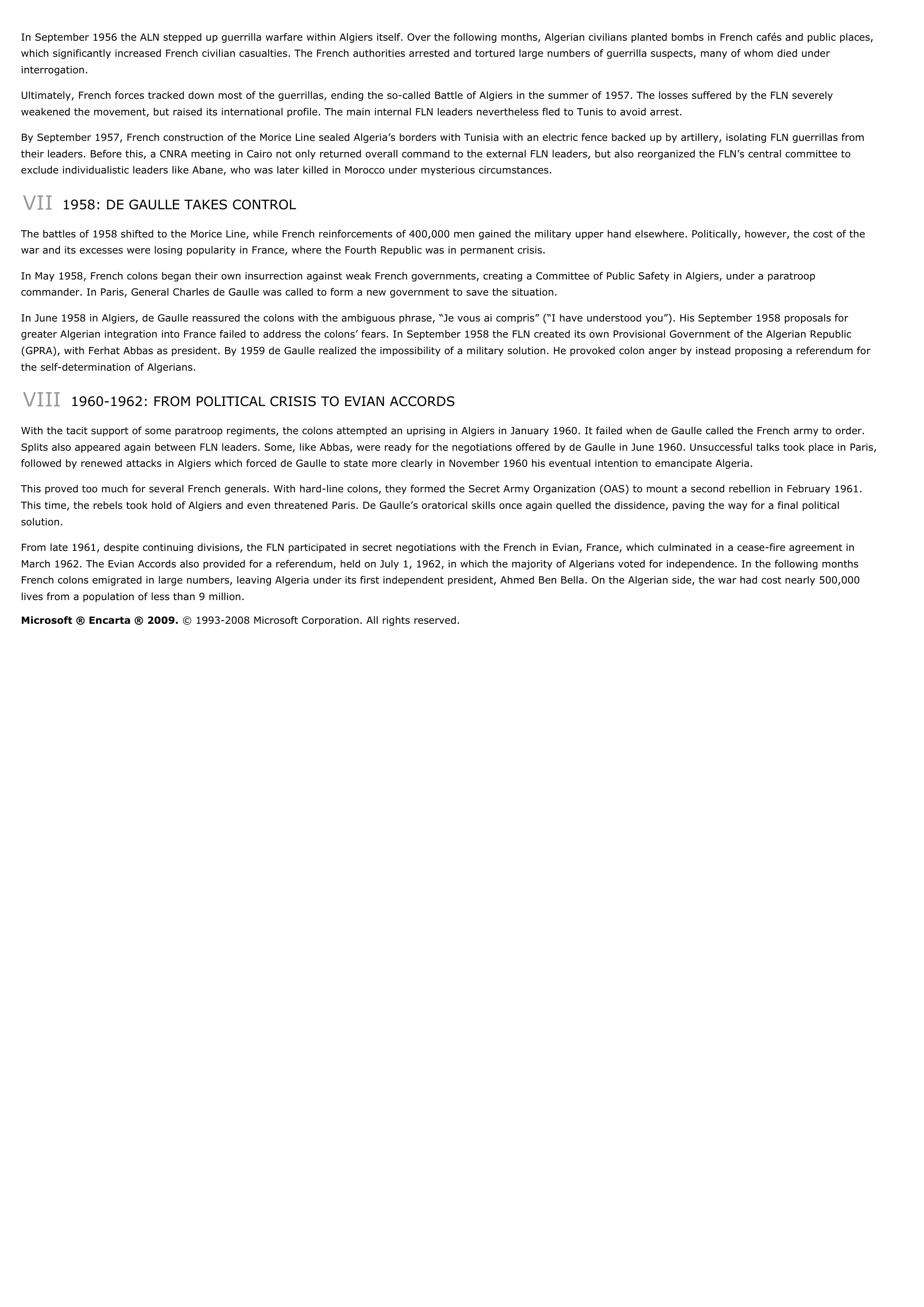Algerian War of Independence - history.
Publié le 26/05/2013
Extrait du document
«
In September 1956 the ALN stepped up guerrilla warfare within Algiers itself.
Over the following months, Algerian civilians planted bombs in French cafés and public places,which significantly increased French civilian casualties.
The French authorities arrested and tortured large numbers of guerrilla suspects, many of whom died underinterrogation.
Ultimately, French forces tracked down most of the guerrillas, ending the so-called Battle of Algiers in the summer of 1957.
The losses suffered by the FLN severelyweakened the movement, but raised its international profile.
The main internal FLN leaders nevertheless fled to Tunis to avoid arrest.
By September 1957, French construction of the Morice Line sealed Algeria’s borders with Tunisia with an electric fence backed up by artillery, isolating FLN guerrillas fromtheir leaders.
Before this, a CNRA meeting in Cairo not only returned overall command to the external FLN leaders, but also reorganized the FLN’s central committee toexclude individualistic leaders like Abane, who was later killed in Morocco under mysterious circumstances.
VII 1958: DE GAULLE TAKES CONTROL
The battles of 1958 shifted to the Morice Line, while French reinforcements of 400,000 men gained the military upper hand elsewhere.
Politically, however, the cost of thewar and its excesses were losing popularity in France, where the Fourth Republic was in permanent crisis.
In May 1958, French colons began their own insurrection against weak French governments, creating a Committee of Public Safety in Algiers, under a paratroopcommander.
In Paris, General Charles de Gaulle was called to form a new government to save the situation.
In June 1958 in Algiers, de Gaulle reassured the colons with the ambiguous phrase, “Je vous ai compris” (“I have understood you”).
His September 1958 proposals forgreater Algerian integration into France failed to address the colons’ fears.
In September 1958 the FLN created its own Provisional Government of the Algerian Republic(GPRA), with Ferhat Abbas as president.
By 1959 de Gaulle realized the impossibility of a military solution.
He provoked colon anger by instead proposing a referendum forthe self-determination of Algerians.
VIII 1960-1962: FROM POLITICAL CRISIS TO EVIAN ACCORDS
With the tacit support of some paratroop regiments, the colons attempted an uprising in Algiers in January 1960.
It failed when de Gaulle called the French army to order.Splits also appeared again between FLN leaders.
Some, like Abbas, were ready for the negotiations offered by de Gaulle in June 1960.
Unsuccessful talks took place in Paris,followed by renewed attacks in Algiers which forced de Gaulle to state more clearly in November 1960 his eventual intention to emancipate Algeria.
This proved too much for several French generals.
With hard-line colons, they formed the Secret Army Organization (OAS) to mount a second rebellion in February 1961.This time, the rebels took hold of Algiers and even threatened Paris.
De Gaulle’s oratorical skills once again quelled the dissidence, paving the way for a final politicalsolution.
From late 1961, despite continuing divisions, the FLN participated in secret negotiations with the French in Evian, France, which culminated in a cease-fire agreement inMarch 1962.
The Evian Accords also provided for a referendum, held on July 1, 1962, in which the majority of Algerians voted for independence.
In the following monthsFrench colons emigrated in large numbers, leaving Algeria under its first independent president, Ahmed Ben Bella.
On the Algerian side, the war had cost nearly 500,000lives from a population of less than 9 million.
Microsoft ® Encarta ® 2009. © 1993-2008 Microsoft Corporation.
All rights reserved..
»
↓↓↓ APERÇU DU DOCUMENT ↓↓↓
Liens utiles
- Algerian War of Independence.
- Algerian War of Independence.
- Boer War - history.
- War of 1812 - History.
- French and Indian War - Canadian History.

































